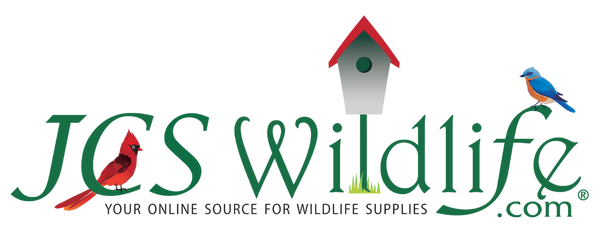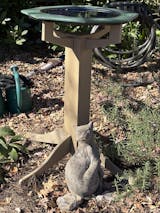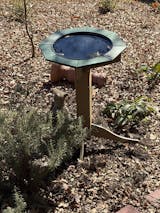If you’ve ever spotted a bird that looks like it’s wearing a crimson helmet while tap-tap-tapping away on a tree, chances are you’ve met the Red-headed Woodpecker. With its bold colors, acrobatic antics, and quirky personality, this woodpecker is a favorite among backyard birders—and a true standout in the avian world.
In this blog, we’ll dive into everything you need to know about this striking species, from its habits and habitat to how you can attract it to your yard with help from JCS Wildlife.
1. Red-Headed Woodpecker: A Snapshot
The Red-headed Woodpecker (Melanerpes erythrocephalus) is one of North America’s most visually stunning woodpeckers. Its bright red head, snow-white belly, and black-and-white wings make it look like it flew straight out of a comic book.
- Size: About 7.5–9 inches long
- Color: Red head, white underparts, black back with white wing patches
- Call: A loud, shrill “queeah” and various chattering sounds

2. Where Do Red-Headed Woodpeckers Live?
These birds are found across the eastern and central United States, especially in open woodlands, forest edges, and areas with dead trees (snags). They love places where they can perch, drum, and forage for insects or stash acorns.
Hot Tip for Birders in Indiana: You’re in prime territory! Keep an eye out in state parks, nature preserves, and even your own backyard.

3. What Do Red-Headed Woodpeckers Eat?
Unlike some of their woodpecker cousins who stick to insects, the Red-headed Woodpecker is a bit of a foodie. Their diet includes:
- Beetles, ants, and other insects
- Nuts and seeds (especially acorns)
- Fruits like cherries and berries
- Occasionally small rodents or bird eggs
They’re also known for caching food—storing it in tree crevices for later. Smart and stylish!

4. How to Attract Red-Headed Woodpeckers to Your Yard
Want to roll out the red carpet for these feathered celebrities? Here’s how:
- Offer suet feeders: High-energy suet cakes are a favorite.
- Provide peanuts and sunflower seeds: Use platform feeders or hopper feeders.
- Leave dead trees standing: If safe, snags provide nesting and foraging spots.
- Plant native fruiting trees: Think dogwoods, serviceberries, and wild cherries.
Check out the woodpecker-friendly feeders and suet cakes available at JCS Wildlife!

5. Red-Headed vs. Other Woodpeckers: Who’s Who?
| Species | Head Color | Belly | Wing Pattern | Common Region |
|---|---|---|---|---|
| Red-headed Woodpecker | Entirely red | White | Black with white patches | Eastern/Central US |
| Red-bellied Woodpecker | Red crown and nape | Pale with reddish tint | Black and white barred | Eastern US |
| Pileated Woodpecker | Red crest | Black | Large white wing patches | Forested areas across US |
| Downy Woodpecker | Small red patch on head | White | Black and white spots | Widespread |
6. Nesting and Breeding Behavior
Red-headed Woodpeckers are cavity nesters, meaning they excavate holes in dead trees or utility poles. They’re monogamous and fiercely territorial during breeding season.
Fun Fact: Both parents help incubate the eggs and feed the chicks. Teamwork makes the dream work!

7. Conservation Status: A Bird Worth Protecting
Sadly, Red-headed Woodpecker populations have declined due to habitat loss and competition for nesting sites. They’re listed as Near Threatened by the IUCN.
You can help by:
- Preserving dead trees when safe
- Supporting conservation groups
- Creating bird-friendly habitats with native plants

8. Fun Facts About the Red-Headed Woodpecker
- 🧠 They’re one of the few woodpecker species that store food.
- 🎯 They can catch insects in mid-air—like little feathered ninjas.
- 🧱 They sometimes wedge nuts into bark and hammer them open.
- 🗣️ Their calls sound like a mix between a squeaky toy and a rusty hinge.
- 🏠 They’ve been known to nest in fence posts and even utility poles.
- 🎨 Juvenile Red-headed Woodpeckers have grayish heads that turn red as they mature.
- 🧭 They are known to migrate short distances, especially in response to food availability.
- 🎶 Unlike some woodpeckers, they don’t drum as much to communicate—they prefer vocal calls.
- 🌳 They often return to the same nesting site year after year.
- 🕵️♂️ They sometimes cover stored food with bark or wood chips to hide it from other birds.
- 🛠️ Their strong beaks can excavate cavities in even the toughest dead wood.
- 📦 They’ve been observed removing eggs from other birds’ nests to reduce competition.
- 🧬 The species name 'erythrocephalus' comes from Greek, meaning 'red head'.
- 🎯 They can spot insects crawling on tree bark from impressive distances.
- 🏞️ They prefer open habitats with scattered trees, unlike some woodpeckers that favor dense forests.

9. Red-Headed Woodpeckers in Culture and History
Native American folklore often features woodpeckers as symbols of persistence and protection. The Red-headed Woodpecker, with its bold colors, has also appeared in stamps, art, and even military insignia.

10. Shop Woodpecker Essentials at JCS Wildlife
Ready to welcome these charismatic birds to your backyard? JCS Wildlife has everything you need:
- Suet feeders
- High quality suet cakes
- Peanut feeders
- Seed blends
- Seed cylinders
- Seed cakes
- Bird baths
Explore our full selection at JCSWildlife.com and turn your yard into a woodpecker wonderland!
Final Peck of Wisdom
The Red-headed Woodpecker is more than just a pretty face—it’s a clever, adaptable, and entertaining bird that deserves a place in your backyard and your heart. Whether you’re a seasoned birder or just getting started, spotting one of these crimson-capped characters is always a thrill.
So grab a feeder, stock up on suet, and keep your binoculars handy. The Red-headed Woodpecker might just be your next feathered visitor!





